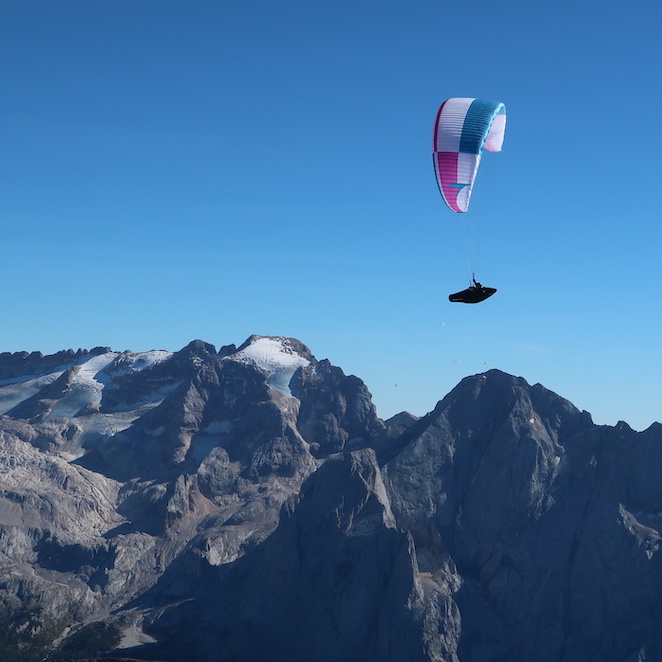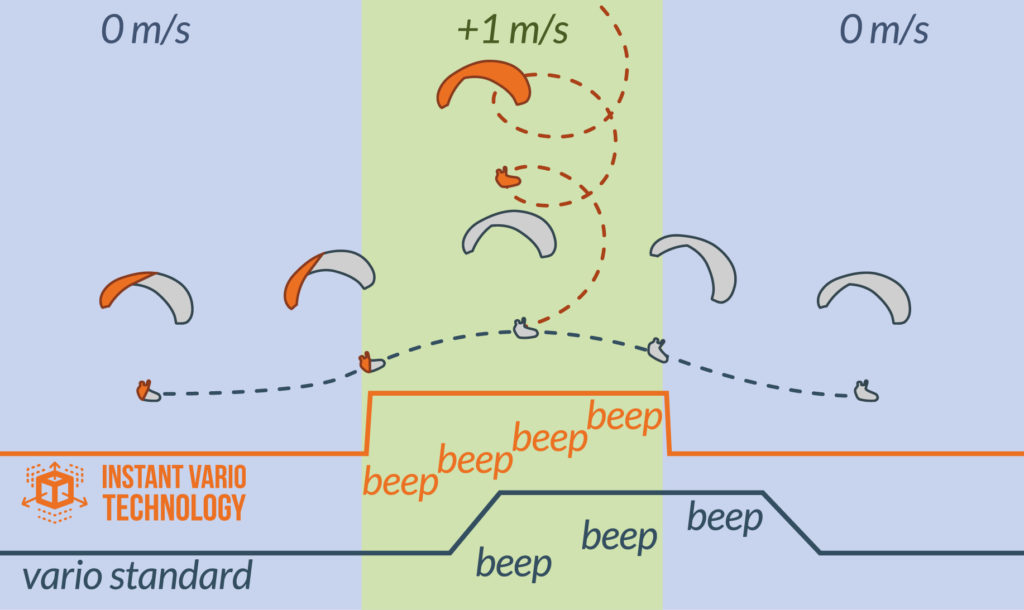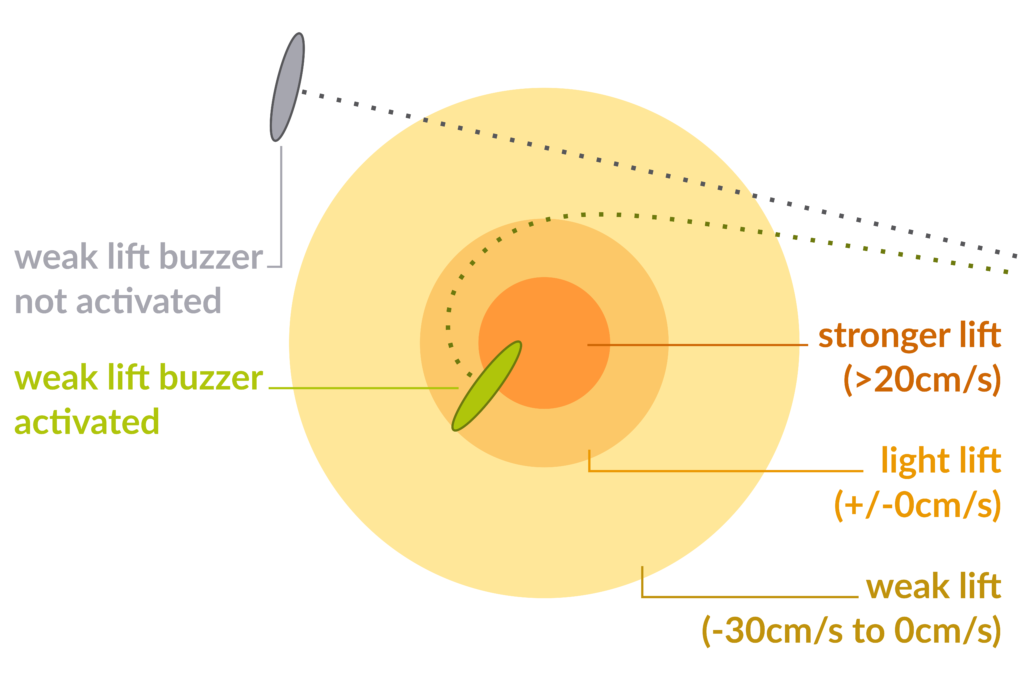The audio variometer: the indispensable companion for paragliders
Beginners, intermediates, experienced pilots, competitors, tandem pilots: everyone wants to stay in the air as long as possible (even acrobats!). This is the primary function of the variometer: to indicate vertical speed (in metres per second in the paragliding world, in feet per minute in aeronautics).
This indication of the rate of climb (positive values) helps the pilot to find ascents, and to roll into them better, but also to 'float' better and move through the air mass, to lose as little altitude as possible, staying around the best possible rate of climb.
Finally, the sink rate (negative values) is used to measure the speed of descent "downwards". If the sink rate is too high, then the air mass is not favourable at this point, and you need to get out of this zone by finding a better route and/or accelerating.
Why fly with a vario?
For human beings, flying is of course unnatural and has no dedicated sense of evolution in 3D. As soon as we lose our visual reference to the ground, it's very difficult to know whether we're going up or down.
However, in the harness, I can feel when I'm entering or leaving a lift.
Our brains use three senses to tell us whether or not we are moving: the inner ear, proprioception and vision.
The brain then mixes these 3 pieces of information precisely to find out where you are in space, in what rotational movement, and at what acceleration.
Unfortunately, we lack 'absolute' speed information: it's impossible to tell how fast a plane or train is going if the curtain is down.
Even our senses can deceive us, for example: when you're in a TGV at the station and the train next to you starts up, you get confused, and your brain has trouble knowing whether you're really moving or not until you turn your head to see the station platform standing still on the other side.
When you're in an established thermal, there's no acceleration even though you're still climbing, and if you're far from the terrain, with no visual reference, it's very difficult to know whether you're actually in the thermal.
The variometer provides us with this missing information and the response is immediate, so we know whether we're going up or down, and at what speed!


How does a vario work?

As we saw earlier, the human body naturally has "3 sensors" for situating itself in space:
- a gyroscope : the inner ear, which tracks rotation (on 3 axes).
- an accelerometer : our skin in contact with the ground, the car seat, the harness, etc., which allows us to follow accelerations (horizontal, vertical).
- a visual reference : Sight, which uses horizontal and vertical reference points to give an absolute reference to the 2 previous senses.
Unfortunately, we don't have an essential means of determining altitude: a virtual vertical ruler graduated in metres, for example.
The information that is missing, but nevertheless present, is pressure. Pressure is directly correlated with altitude. So a pressure sensor can be used to measure the decrease in pressure as altitude increases.
In the context of a variometer for paragliding, absolute altitude is of little interest to us; it's the variation in altitude that interests us.
So, by reading the pressure very frequently (at least 50 times a second, up to 100 or 200 times a second in the fastest cases), it is possible, with high-performance signal processing, to determine the variation in altitude, i.e. the vertical speed.
Is it possible to have a totally instantaneous vario?
Measuring pressure alone can sometimes be insufficient: a variation in pressure is needed to measure vertical speed, so the information obtained is always slightly delayed.
This is why an acceleration sensor is used to measure the acceleration (entering the thermal) as quickly as possible: this is instantaneous vario.
Of course, this accelerometer sensor is extremely sensitive and requires an absolute reference point: gyroscopic correction is necessary.
An entire measurement chain (accelerometer, gyroscope, pressure), measured more than 100 times a second using a cutting-edge algorithm, is used in the device to provide the driver with information that is perfectly in tune with his or her sensations.
The algorithm Instant Vario Technology is exclusive to Stodeus.
It combines information from three sensors: the accelerometer, the gyroscope and the barometer. As a result, the pilot gets a vario response 'exactly' at the start of the thermal, and not just after feeling in the harness that 'it's coming up'. The same applies to the exit of the thermal, which is just as important: the vario stops immediately on exiting the thermal.
In other words, the vario is exactly in phase with the pilot's sensations in the harness. Gone is the one-second delay between thermal entry and the start of the vario beeps.


Why a vario with sound modulation?

We need 100% of the visual field to fly, both for safety and to be aware of all the surroundings that can help us find thermals.
The auditory sense is therefore much more available, as it is only used for a few specific items of information such as the ruffling of the wing, the variation in the relative wind, or a radio call.
Using sound (a note) conveys information, while the absence of sound represents the absence of information.
It is therefore necessary to modulate sound (the vibratory frequency of air) to the order of KHz, so it is possible to transmit almost infinite amounts of information.
The beeps used in an audio variometer are made up of three parameters:
- Frequency : pitch of the note (variations from low to high).
- Cycle duration : duration during which the note is played and its pause time.
- Cyclic ratio : ratio between the note played and the pause time. For example, a duty cycle of 50% gives half the time played and half the time in silence.
With an audio vario, our auditory sense acts in total complementarity with the three senses mentioned above, giving us instant and very precise access to information about our vertical movement.
Competitors' opinions

"I can't imagine flying cross-country or bivouac without the sound of the vario. I've set it up so that it's very communicative in low lift followed by a plateau in high varios, so if I'm in +7m/s I know I'm climbing, no need to shout it at me! I like it when it beeps immediately, without delay, but sometimes I train myself to feel different sensations by adding a delay on purpose to recognise when I'm entering a thermal before the beep confirms it.
So, from time to time I put the vario on mute and practise thermalling without the vario. It's easier when you're close to the ground and when there are other pilots around, but sometimes, especially when you're high up or in very small air, it's practically impossible. The sound of the vario makes flying much more accessible because it frees up our attention during the thermal, giving us more time to observe the terrain, the clouds, plan our next transition or simply admire the view. There are solar-powered solutions, with no constraints, the size and weight of a small box of matches, so why deprive myself?
After all, there aren't many sounds more magnificent than the first beep after 20 minutes of laborious scratching at the bottom of a combe, that sound which then becomes increasingly regular and rapid and takes us right up to the ceiling."
Kinga Masztalerz, Red Bull X-Alps athlete, flight-bivouac adventurer.
"I had a bit of trouble at first with the instantaneous response of this new generation of varios. With the old varios, you used to get confirmation of the thermal bubble after you'd felt it, but now you get the information at the same time as you feel it. It's disturbing at first, but now it's impossible to go back!
It's really interesting to know straight away if you're really going up or if you're only going down less, so you can react more quickly and perform better."
Jacques Fournier (alias Grand Jack), international competitor.

Vario Tone Editor: the ultimate tool for fine-tuning your vario
of your UltraBip
Here you'll find all the information you need to exploit the full potential of the Vario Tone EditorUltraBip vario setting tool (accessible to all, even without UltraBip) .
The Vario Tone Editor is also available in the Configurator of the GPSBip / GPSBip+ (the predecessor of the UltraBip).

Le Vario Tone Editor allows you to adjust the 3 parameters that make up the sound, graphically and intuitively:
As we saw earlier, there are 3 essential components:
Beep frequency curve :

Cycle time curve :

The duty cycle curve :

What shapes should the curves take?
It is important to adapt the type of sound response according to the rate of rise/fall encountered and the level of riding.
A linear response doesn't allow us to make the most of our sense of hearing. What's more, it's much more interesting to have more information on small thermals of +0.5m/s gently increasing towards +1m/s (gain of 100%) rather than in a monster of +6m/s tending towards +7m/s (gain of 15%).
That's why most varios offer a logarithmic curve (often of the 3 parameters, with certain variations).
The Vario Tone Editor not only allows you to modify these 3 parameters, but also to define different types of response:
Quick answer (example):
Damped response (example) :
The descent alarm
Both dreaded and viscerally loathed, this function allows the pilot to detect a sink rate greater than the nominal sink rate of his glider in calm air (generally between -0.8 and -1.7m/s for a standard glider).
The aim is to inform the pilot that he is in a strongly descending air mass, which will cause him to lose a lot of altitude and may even force him to land if he stays too long in this zone.
It is up to the pilot to set the right threshold according to his level and ability to manage this information in flight.
Generally speaking, a beginner pilot will tend to deactivate this function because it can be perceived as too stressful, an intermediate pilot will want a descent alarm at around -3m/s, and generally a competitor will prefer to set it at -2m/s, even if it means that it is triggered as soon as the pilot exits the thermal.
Zeroing, or low lift detector
This sound is made up of short modulations indicating to the pilot weak lift (from -30cm/s to his climb rate setting, by default +20cm/s), not strong enough to roll, but which will help him find the nearby thermal.
In the image, the pilot in grey has not activated the zeroing function, whereas the pilot in green has activated it. When he reaches the zone of weak lift, the zeroing beeps are activated, informing the pilot that he is approaching a zone of weak lift, not yet optimal for furling, but inviting him to remain attentive as a stronger thermal may be nearby.

Sound volume
Variometers are, or should always be, adjustable with at least 3 sound volumes, so that the volume can be adapted to suit the use. When the vario is placed on the helmet, in a two-seater for example, the minimum volume ensures that it remains discreet and does not disturb the passenger.
In a high-performance sail, or with a noisy helmet in a relative wind, the medium volume will be used.
Finally, in the cockpit, in the prone position, with a full-face helmet, a high volume of sound is required.
The volume of the UltraBip (like all STODEUS instruments) can be easily adjusted to these three levels using the side-mounted knob, even during flight.
And why not pass on the information in another way?
Other non-visual technologies are also possible, such as vibrations.
But vibrations, and even more so modulations (variations) within vibrations, are much more difficult to perceive. It is not possible to convey through vibrations as much information as sound can contain.
What's more, they can be easily interfered with. For example, missed calls on the smartphone vibrating while you're walking.
Lastly, it's a technology that consumes comparatively enormous amounts of energy: you have to move (or vibrate) a mass (device, hand, body), whereas sound is the vibration of air (by definition much lighter).

As the pilot is solely responsible for the safety of his flights, STODEUS cannot be held liable in any way for this article. It is up to the pilot to make his own adjustments according to his level of piloting and his ability to manage this information in flight.

